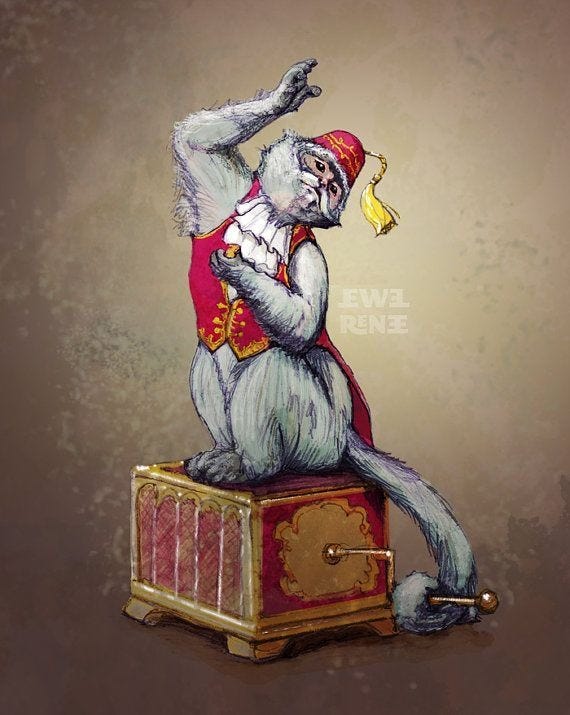February 25 - Penny Wonder: The First Monkey Show in America
Spiritual Growth Amidst Worldly Amusements
This is the day the first performing monkey was exhibited in America in 1751.
In today's devotional, we will explore the delicate balance between enjoying the world's entertainments and fostering our spiritual growth. How can we navigate the delights of amusement without losing focus on our faith journey? What lessons can the simple joy of a historical spectacle teach us about prioritizing our spiritual well-being?
"So whether you eat or drink or whatever you do, do it all for the glory of God." - 1 Corinthians 10:31 (NIV)
This Date in History
On February 25, 1751, New York City witnessed a peculiar and novel form of entertainment: the first performing monkey ever exhibited in America. The event took place against a backdrop of a young, burgeoning nation still under colonial rule, where daily life was often harsh, and entertainments were few and far between. This singular attraction offered a rare diversion and was advertised widely, with the price of admission being a mere one cent, making it accessible to a wide audience.
The origins of this performing monkey, like many exotic curiosities of the time, are shrouded in mystery. Likely brought from distant lands by sailors who traveled between the continents, this monkey was a living souvenir of the vast, largely unknown world beyond the American colonies. Its appearance in New York City was not just a novelty; it was a symbol of global connections and the growing curiosity about the natural world and its many wonders.
The performance itself would have been a simple affair by today's standards, but at the time, it was a marvel. The monkey may have been trained to do a variety of tricks—dancing, picking up objects, even mimicking human behavior, all to the delight and astonishment of an audience unfamiliar with such animal displays. This event was not just about the monkey's performance but also about the human reaction to it, reflecting the era's fascination with the exotic and the boundaries between the civilized world and the natural one.
Following the show, the legacy of the first performing monkey in America continued to ripple through society. It opened the door for more animal exhibitions and shows, laying the groundwork for future entertainment in America, from traveling circuses to theatrical productions. The show's success highlighted an appetite for public entertainment and signaled a shift in social activities and urban life, where people sought collective experiences that provided amusement and escape from daily routines.
The 1751 monkey exhibition stands out as a curious footnote in American history, indicative of the era's complexities, curiosities, and cultural shifts. It was a moment when the boundaries of entertainment were expanded, reflecting a society in the midst of transformation and a people ever eager for the wonders of the world, be they from distant lands or, as in this case, the animal kingdom brought to their doorstep.
Historical Context
In the mid-18th century, America was a land undergoing significant change and development. It was a period of colonial expansion, economic growth, and cultural exchange. The exhibition of the first performing monkey in 1751 occurred during an era when the colonies were still heavily influenced by European customs, trade, and entertainment. This event was a small but telling part of the larger tapestry of colonial American life, reflecting a growing public interest in novelty and entertainment.
During this time, public exhibitions, rare animal shows, and scientific demonstrations began to take root in urban centers. The display of the performing monkey in New York City was a manifestation of these changing tastes and the increasing public appetite for entertainment and diversion. It was a time when the boundaries of the known world were expanding, and people were keen to experience its wonders firsthand, whether through stories of distant lands, exhibitions of exotic animals, or theatrical performances.
Furthermore, the event highlighted the dynamics of urbanization and commercialization in colonial America. New York City, like many urban centers at the time, was becoming a hub of commercial activity and cultural exchange. The introduction of such novel entertainment was made possible by the growing infrastructure of the city and its emerging status as a cultural and economic center. The show also reflected the broader transatlantic trade that brought goods, ideas, and even animals to the American colonies, linking them more closely to the global economy and cultural trends.
This period was also one of scientific curiosity and enlightenment thought, where the natural world began to be understood and appreciated in new ways. The public exhibition of a monkey, an exotic animal not native to the American continent, would have sparked curiosity and wonder, contributing to a broader interest in natural history and the classification of species. This curiosity was not limited to the elite; it permeated society, influencing public entertainment and the kinds of spectacles that were popular among all classes.
Did You Know?
Sailors often kept monkeys and other exotic animals as pets or mascots on long voyages, and these animals were sometimes sold or gifted upon reaching port, introducing new species to the American public.
Today’s Reflection
In 1751, a single performing monkey captivated the attention of New Yorkers, symbolizing a moment where simple amusement could unite diverse groups in a shared experience of wonder and entertainment. This spectacle, while seemingly trivial, speaks to a deeper human inclination to seek out and enjoy diversion and novelty. As followers of Christ, it invites us to consider how we engage with the entertainments and distractions that fill our own lives.
The Apostle Paul reminds us in 1 Corinthians 10:31 that whatever we do, even in our moments of leisure and entertainment, should be done for the glory of God. This verse isn't just a call to action but a call to consciousness about how we integrate our faith with every aspect of our lives, including how we entertain ourselves. It challenges us to consider if our choices in entertainment align with our commitment to glorify God in all things.
In the context of the first monkey show in America, entertainment was scarce and sought after, a momentary escape from everyday struggles and a chance to experience something out of the ordinary. Today, we live in an age of constant amusement, with entertainment at our fingertips. This abundance makes it all the more important to discern how these activities fit into our spiritual lives and how they affect our relationship with God and others.
While entertainment in itself is not bad, the balance lies in our approach and the place it occupies in our lives. Entertainment can become a distraction, a way to fill every silence, or an escape from the discomforts of life and even our spiritual obligations. The question isn't just about what we are watching or engaging with but also about what we might be neglecting or overlooking in the process—our time with God, with our families, or serving others.
The balance is found in moderation and intentionality. It involves asking ourselves whether our entertainment choices uplift, edify, and bring us closer to God or whether they pull us away from Him. It's about making space for God in every part of our day and ensuring that our leisure activities don't overshadow our time spent in prayer, scripture reading, and fellowship.
As we reflect on the historical novelty of a monkey's performance and the crowds it drew, let us also consider how we might be drawn to the spectacles of our time. Let's commit to seeking entertainment that not only brings joy and relaxation but also honors God and reflects our values as His followers. In doing so, we ensure that our lives reflect a continuous act of worship, integrating our faith seamlessly with every aspect of our daily lives, including our choices in entertainment.
Practical Application
Reflect on your current entertainment choices and schedule a specific time this week for quiet reflection or a spiritual activity that you've been neglecting. Use this time to reconnect with God, perhaps through meditating on a Psalm or walking in nature, consciously seeking to balance the joy of earthly entertainment with the deeper joy found in spiritual growth.
Closing Prayer
Heavenly Father, guide us to discern and enjoy the good things You've placed in our world while keeping our hearts focused on You. Help us to balance our leisure with our spiritual growth, finding joy and satisfaction in both, but always prioritizing our relationship with You above all else. Amen.
Final Thoughts
In balancing the enjoyment of entertainment with our spiritual growth, we are called to navigate the joys of life while deepening our faith. Today's reflection on the first monkey exhibition in 1751 serves as a reminder that while entertainment has its place, our ultimate joy and fulfillment come from our relationship with God. Let us embrace this balance, finding in every amusement an opportunity to glorify Him.
Community Engagement
I love hearing from readers each day. Don’t worry, this isn’t a test—I promise! Feel free to drop a line or two in the comments below. You can answer one of the following questions, share your own reflections, pose a new question, or simply say hello. I can’t wait to hear from you!
What is one form of entertainment you enjoy, and how do you ensure it aligns with your faith?
How does today's historical event inspire you to think about the balance between amusement and spiritual growth?
In what ways can you better integrate your faith with your entertainment choices?
Reflecting on today's devotional, what is one step you can take to more deeply engage with your spiritual life even as you enjoy the world's entertainment?
In tomorrow's devotional, we'll journey through the hidden corridors of courage, exploring the silent, yet powerful ripples one person's faith can create in the tumultuous sea of history. Discover the unseen impact of righteous conviction and how it molds the world's narrative.






